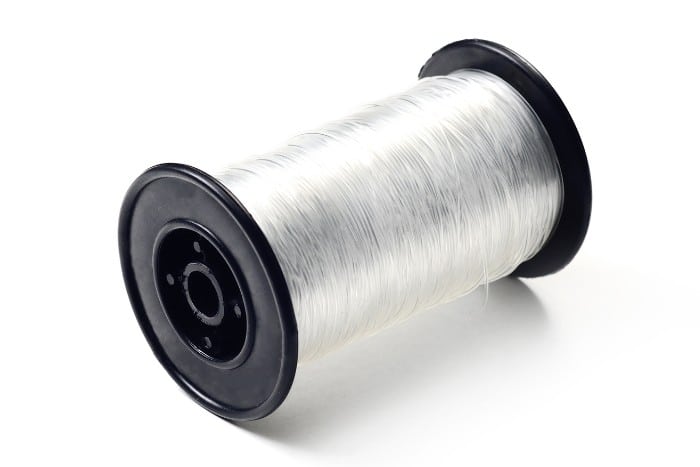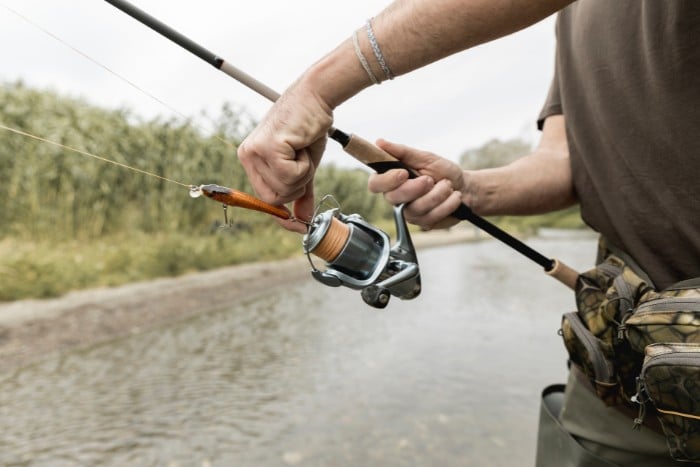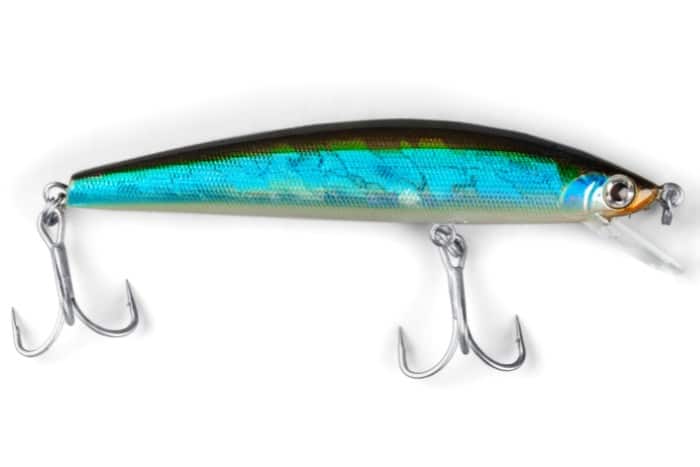There are four types of lines that people use for bass fishing with a rod and reel. Each material has different properties that impact how durable it is, what conditions it works best in, and what style of lure you should use with that line.
When bass fishing, you’ll have four material choices: braided line, monofilament, fluorocarbon, and co-polymer. As a general description, monofilament is the best option for versatility, braid is the best for strength, fluorocarbon is nearly invisible, and co-poly is the best of fluoro and mono.
Keep reading to learn more about the three fishing line materials, when you should use each, and how to select the correct size.
How To Use Monofilament Fishing Line For Bass?
Fifty years ago, monofilament was the only fishing line option; even today, it remains the most popular choice.
Monofilament is the primary fishing line that most people are familiar with, and even though it is the oldest material, it remains a great choice.
Monofilament, as the same suggests, is made of a single fiber of a plastic material, usually nylon.
Nylon is famous because it is inexpensive and easy to manufacture in different diameters to create other strength lines.
1. Selecting The Right Pound Test
Selecting the proper pound test for bass fishing depends on several factors in your fishing environment and gear.
A lighter line will work well for open water without a lot of cover to get snagged on, while a heavier line for fishing in areas with lots of plant life.
If you only have one fishing rod to catch panfish, trout, and other small species, as well as the occasional bass, you can use a six-pound test line.
A six-pound line will be small enough that you can catch line-sensitive fish and strong enough to handle most bass.
However, if you only have a fishing combo for bass, you’ll want to upgrade to a monofilament in the 8-20 pound range.
An 8-15 pound line is excellent for finesse presentations and lightweight spinning lures in relatively open water.
Meanwhile, a 15-20 pound line works better for heavier lures in areas with plant cover where you might get snagged in grass or weeds.
2. Advantages Of Using Monofilament
Monofilament is the most popular fishing line- it works well in most situations and circumstances. Monofilament would be a great choice if you could only use one fishing line material.
One advantage of monofilament is that it is clear enough to be mostly invisible underwater.
Which is great because if a fish can see the line, it probably won’t bite (although bass are not known to be the most intelligent fish).
Another key advantage is monofilament has a high tensile strength, so it won’t break when you hook into a lunker.
It is also very forgiving, offering some stretching before breaking to know if you need to adjust the drag on the fly.
Monofilament is widely available and inexpensive, so replacing it is never an issue. It is also simple to use, as you don’t need to use a leader line and can tie straight to the line for an easy way to get started.

3. Drawbacks To Using Monofilament Fishing Line For Bass
Monofilament is a great line for general use, but that doesn’t mean it is the best to use in all situations.
As bass anglers dive deeper into the different methods and applications, many of them will opt to use braid and fluorocarbon in most cases.
Another drawback of monofilament is its ability to stretch, making it less sensitive than sturdier line choices.
Compared to using a braided line, you might not notice some gentler movements and, consequently, miss some bass.
A final drawback to monofilament is its lack of smooth casting ability, especially for baitcasting reels.
Many experienced anglers find that monofilament limits their accuracy and casting distance, so other materials are preferred.
4. Best Lures And Techniques To Use With Monofilament
Monofilament is a versatile line that an angler can use with pretty much any lure, but it does best with crankbaits, poppers, spinnerbaits, and small swim baits.
However, you can undoubtedly use monofilament for any common lure.
Since monofilament naturally floats, it works well for topwater baits, helping to keep them at the surface without the weight of the line dragging them down.
Even a tiny amount of extra weight can interfere with the action of topwater lures.
The lures listed above are great for monofilament because the bass will strike the lures hard, and the tendency for mono to stretch.
This built-in shock absorber helps you hook up with the fish.
Monofilament becomes a worse option for more sensitive and finesse techniques as the distance between you and the lure increases.
The stretchy nature of the line means that the more line you have out, the less likely you’ll be able to tell if there is a bite on the line.
How To Use Braid Fishing Line For Bass?
The braided line is a popular choice for competitive bass anglers, and for good reason. Braid offers the highest tensile strength, the smallest diameter, and other qualities that make it great in any scenario.
1. Selecting The Right Pound Test
Compared to other options, braid offers incredibly high tensile strength with a small diameter, which is excellent for running a high-pound test line and still having 200+ yards to work with on your reel.
It might help if you chose a 30-pound braid for general-use bass fishing or a lighter 10-pound test for finesse presentations.
As a point of reference, a 30-pound braid is about the same diameter as eight-pound monofilament, and a 65-pound braid is the same as a 20-pound monofilament.
Anglers prefer this increased tensile strength because the braided line is 3-4 times stronger at the same diameter.
For bass fishing, significantly, this cuts down on the chance of losing a lure in a snag or having a fish break off.

2. Advantages Of Using Braid For Bass Fishing
Not only is the braid stronger than other lines, but it also casts smoother than other lines.
Monofilament and fluorocarbon have a line “memory,” which is kinks and twists from being wound around a spool. Memory can cause the loops around the reel to reform after casting.
Line memory can also result in a tangled line after casting, which means you’ll have to spend time untangling rather than fishing.
Braid, however, never develops any “memory” and, therefore, won’t tangle for the same reasons.
Another benefit of using braid is that it does not stretch at all, giving anglers the ultimate sensitivity, even over long distances. A lack of stretch makes it ideal for finesse techniques when paired with a leader line.
Braid, being such a strong material, is excellent for casting topwater baits into thick vegetation and is almost required to catch fish with frog lures.
A braided line is ideal for large lures when paired with a heavy rod, strong enough to cast lures weighing three or more ounces without damaging the line.
3. Drawbacks To Using Braided Fishing Line For Bass
Using braid has a few drawbacks; however, most anglers agree that the benefits outweigh the disadvantages.
Cost is one of the first drawbacks, as braid will be more expensive than monofilament.
Not only is it more expensive, but it will fray easily, and the line will be compromised, so if you fish in rocky areas, you might replace the line more frequently, adding to the cost.
Another drawback is that braid is highly visible underwater, unlike the clear mono and fluoro, which are nearly invisible options.
You can easily hide braided line, however, by using a monofilament or fluorocarbon leader, but learning to tie a leader is a lot of extra work for someone just wanting to get out and start fishing.
Tying knots with braid is more difficult than using monofilament, but learning the Palomar knot for tying onto lures and terminal tackle and learning the Double Uni knot for leader lines will serve you well.
4. Best Lures And Techniques To Use With Braided Line
Using a braided line alone works for reactionary strikes, but it is easily visible and might scare fish away. Since scaring the fish is generally not preferred, many anglers use a leader line, especially in clear water.
Braided line with a 10-14 pound fluorocarbon leader between one and ten feet long will work with any lure or technique you might want.
The length of your leader can range based on personal preference; a longer leader means you do not need to replace it as often, while a shorter leader will need to be replaced more often, but you can avoid the knots hitting your guides and getting tangled.
Braided line works exceptionally well when casting over long distances, with incredible sensitivity meaning that any nibble will be noticed.
Jigs, Texas rigs, and deep diving crankbaits all benefit from the sturdy nature of braid.
How To Use Fluorocarbon Fishing Line For Bass?
Fluorocarbon is another clear line like monofilament, but it is invisible underwater and has properties that make it a better leader line than mono.
Of the three main types of fishing lines, fluorocarbon is the newest but perhaps the most revolutionary.
In the 1990s, bass anglers began to use fluorocarbon leaders, and since then, it has become the most used leader material and a relatively popular main line material.
1. Selecting The Right Fluorocarbon To Use
Fluorocarbon comes in two different styles, one that is made to be the main line and the other as a leader line.
Both options work well, but most people prefer to use a leader rather than the main line due to the high price of the material.
Fluorocarbon to be used as the main line is more flexible and has a thinner diameter than the leader material, which helps it cast smoothly and prevents it from getting tangled due to the line memory.
Leader material, on the other hand, is stiffer, helping increase its resistance to stretching and making it strong and abrasion resistant.
All of these qualities help supplement the weaknesses of braid, making the pairing an excellent choice for bass fishing.
When selecting which fluorocarbon line to purchase, choose a high-quality manufacturer. Top-of-the-line fluorocarbon will have an additional coating for reduced underwater visibility and will have less stretch.
2. Advantages Of Using Fluorocarbon For Bass Fishing
Whether you’re using fluorocarbon as a leader or a main line, there are plenty of advantages. In many ways, fluorocarbon is an upgrade to monofilament fishing lines, with only a handful of negatives.
Compared to monofilament, fluoro is more resistant to abrasion, UV rays, and extreme temperatures and does not break down in the water.
Fluorocarbon is also denser than monofilament, meaning it will easily sink, which is excellent for non-topwater lures.
Fluorocarbon has a refractive index almost the same as water, making it invisible underwater. Put simply, water and fluorocarbon bend light the same way when it passes through.
3. Drawbacks To Using Fluorocarbon Fishing Line For Bass
The first drawback to using fluorocarbon for bass fishing is the price compared to other fishing lines. Fluorocarbon can cost 3-5 times as much as other options, which is enough to scare many anglers away.
The high price is why using a leader is seen more because you only use a few feet at a time rather than needing several hundred yards to fill the spool.
Another drawback to using fluorocarbon is at the same diameter as braid. It has a much lower tensile strength.
In most cases, this isn’t a problem, but the leader and knots will be a weak point in your line where it might break off and result in a lost fish.
4. Best Lures And Techniques To Use With Fluorocarbon
Because fluorocarbon is denser than water and will sink quickly, it is not the best choice for topwater lures. However, for any other lure or technique, fluorocarbon will work perfectly.
For finesse and delicate methods, the near invisibility of fluorocarbon will trick even the most careful fish.
It also doesn’t stretch much and is abrasion resistant, so you don’t need to worry about not feeling a bite or having a line break because you got hung up on a rock.
I like to use a fluorocarbon leader on all my bass fishing combos, with braid as the main line. The only times I don’t use this setup are fishing for other species or a topwater lure.

5. What About Co-polymer Lines?
Co-polymer fishing lines are perhaps the least talked about option in the bass fishing world.
Still, they are gaining popularity and are a good “jack of all trades” option, spitting the benefits of fluorocarbon and monofilament lines.
Co-polymer has many of the same benefits as fluorocarbon but comes at a more affordable price.
Co-polymer line is made of two polymers, one that offers the qualities of fluorocarbon and a less expensive polymer that is more like monofilament.
Combining these two materials creates a less expensive line than fluorocarbon with the same low visibility underwater.
Co-poly also has the benefit of better knot retention thanks to the extra flexibility of the monofilament-like material.
Many anglers are starting to switch to co-polymer lines thanks to the low price tag compared to fluorocarbon, without many drawbacks.
If you’re looking to save a bit of cash but still want to experience fishing line that is similar in many ways to fluorocarbon, a co-poly might be for you.
Wrapping Up!
In conclusion, the best fishing line to use for bass depends on where you are fishing and what techniques and lures you use.
If you’re new to bass fishing and want to get out there, a 10-15 pound monofilament will be your best choice.
Once you want to try new things, switching to a braided line or braid with a fluorocarbon leader will be much more sensitive and stronger.
Using a different fishing line will let you cast into thicker vegetation without losing fish and be more sensitive.
